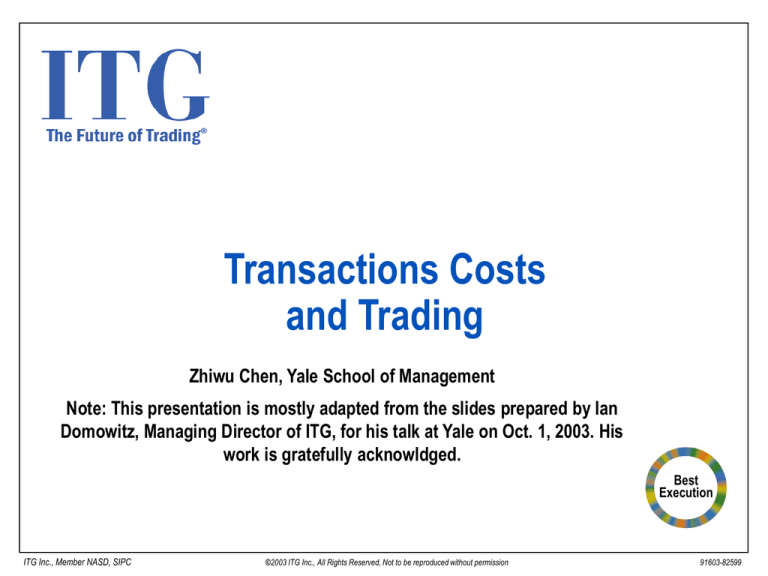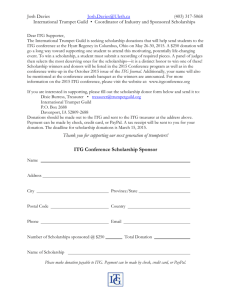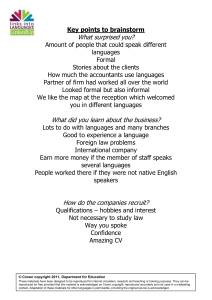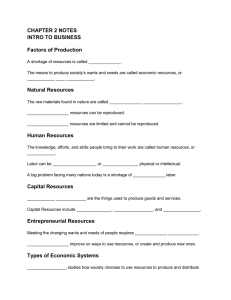
Transactions Costs
and Trading
Zhiwu Chen, Yale School of Management
Note: This presentation is mostly adapted from the slides prepared by Ian
Domowitz, Managing Director of ITG, for his talk at Yale on Oct. 1, 2003. His
work is gratefully acknowldged.
Best
Execution
ITG Inc., Member NASD, SIPC
©2003 ITG Inc., All Rights Reserved, Not to be reproduced without permission
91603-82599
Successful Implementation Strategies
Portfolio Management
Risk analysis
Optimization
Fair value pricing
Pre-Trade Analysis
Trade Blotter
Post-Trade Analysis
Performance vs.
benchmarks
Sorted and
organized
Trading cost
Risk analysis
Optimal horizon
Trade data
Organization
Trading
Access to all
liquidity sources
Logical participation
trading strategies
©2003 ITG Inc. All Rights Reserved, Not to be reproduced without permission
2
Who’s Got the Alpha?*
Two funds:
Large Cap Value
Gross Alpha=13.1%
Small Cap Growth Gross Alpha=17.8%
Both Incur Trading Costs
Components of Transaction Cost
2.00%
1.50%
Market Impact
Opportunity Cost
Bid/Ask Spread
Commissions
1.00%
0.50%
0.00%
-0.50%
Large Cap Value
Small Cap Growth
*John Bogle Jr.. “Transaction Cost and Growth of Assets”
©2003 ITG Inc. All Rights Reserved, Not to be reproduced without permission
3
Will the Real Return (and Risk) Please Stand up?
Large Cap Value
Trade Cost in bp
Turnover
Annual Cost
Small Cap Growth
51
180
600%
325%
51bp*600%*2=
180bp*325%*2=
6.10%
10.80%
Gross Versus Net Alpha
20.00%
18.00%
16.00%
14.00%
12.00%
10.00%
8.00%
6.00%
4.00%
2.00%
0.00%
Net Excess Return
Transaction Cost
Large Cap Value
©2003 ITG Inc. All Rights Reserved, Not to be reproduced without permission
Small Cap Growth
4
Trading Costs Impact Fund Rankings
Top S&P 500 Funds
3 Year Annualized Return
% Return
-9%
Top 25 funds more
pronounced:
Average 8.5 bps
between ranks
-10%
Next 75 funds:
Average 0.6 bps
between ranks
-11%
-12%
0
20
40
60
80
100
Rank
So urce: Lipper
16 bps would move the #50 Fund to #20.
©2003 ITG Inc. All Rights Reserved, Not to be reproduced without permission
5
Three Step Program
Measurement
Regular pre-trade and post-trade measurement
Focus on implicit costs of the entire trade
Analysis
Compare trades to appropriate benchmarks
Aggregate pre-trade and post-trade trade results by meaningful categories to
see hidden costs
Control
Trading as a source of value
Logical participation
Control the attributes of residual portfolios throughout the execution process
©2003 ITG Inc. All Rights Reserved, Not to be reproduced without permission
6
Measurement
Trading costs are more than commissions and spreads
Implicit costs, including market impact, are significant...
But do not omit delay and opportunity costs
midpoint
BID
EXECUTION
ASK
Spread
©2003 ITG Inc. All Rights Reserved, Not to be reproduced without permission
Market Impact
COST
7
Measure Indirect Trading Costs
Paper
Returns
Returns if all
trades were
executed
instantaneously
and with zero
cost at the
decision price
Implementation
Shortfall
Direct Costs
Commissions,
Ticket
charges,Taxes
Indirect Costs
Real
Returns
Trades partially or
fully executed at
prices achievable
in the market, or
not executed at
all
Delay Cost,
Timing Gain/Loss
Market Impact
Opportunity cost
©2003 ITG Inc. All Rights Reserved, Not to be reproduced without permission
8
Types of Costs
PM Decision Price
Release Price
Delay
B/O Midpoint
at Execution time
Timing Gain/Loss
Executed
Price
(Actual)
Market Impact
Executed
Orders
Opportunity Cost
TIME
Opportunity Cost
Unexecuted
Orders
Executed
Price
(Assumed)
©2003 ITG Inc. All Rights Reserved, Not to be reproduced without permission
9
Arbitrageur
©2003 ITG Inc. All Rights Reserved, Not to be reproduced without permission
Price
Anomalies
10
The organization of stock exchange makes a difference to price impact
©2003 ITG Inc. All Rights Reserved, Not to be reproduced without permission
11
On Benchmarks
So many choices, so much confusion
What benchmarks to use?
Miscommunication between traders and portfolio managers symptomatic of
benchmark issues
Traders may perform well versus VWAP benchmark
...but portfolio managers are dissatisfied
Pursuing a VWAP benchmark encourages traders to parcel out their trades over
several days, missing the opportunity to obtain alpha
©2003 ITG Inc. All Rights Reserved, Not to be reproduced without permission
12
Typical Example
INTL (Inter-Tel)
close
10.5
10.0
9.5
9.0
8.5
8.0
7.5
7.0
1/10/01
1/11/01
1/12/01
1/13/01
1/14/01
1/15/01
1/16/01
1/17/01
Original Order: Buy 100,000 INTL 1/10/01 10:46
Executed as follows:
1/10/01 30,000 @ $8.00
1/11/01 20,000 @ $8.75
1/12/01 30,000@ $9.50
1/16/01 20,000@$10.00
©2003 ITG Inc. All Rights Reserved, Not to be reproduced without permission
13
Benchmarks Results
Using Multi-Day, Order-Level
VWAP Benchmark
Cost is Negligible
But Using Decision Price
Cost is 14.25%
©2003 ITG Inc. All Rights Reserved, Not to be reproduced without permission
14
A Study in Timing: an example
The head trader believes costs are too high for relatively liquid stocks
Goal: identify the cost drivers
The trade order management system has time stamps for:
When the order was released by the PM to the desk
When the desk released the order to the broker
When the broker executed the trade
©2003 ITG Inc. All Rights Reserved, Not to be reproduced without permission
15
The Scenario
PM Releases
Order
Trading Desk
Places Trade
Order Received
By Broker
Exec Price
(Actual)
Decision Price
Delay
Timing Gain/Loss
Market Impact
Opportunity Cost (Slippage)
Cost 38 bp
Cost 14 bp
Total Cost 52 bp
Overall transaction costs were 52 bp from
order release to execution
Costs from order release by the PM’s to
the Trading Desk equaled 38 bp per share
Costs from when the trade was placed by the desk
to the Broker were 14 bp per share.
©2003 ITG Inc. All Rights Reserved, Not to be reproduced without permission
16
Costs By Order Size / Market / Side
OrderSize
0 - 99
100 - 499
500 - 999
1000 - 1499
1500 - 2499
2500 - 4999
5000 - 9999
>= 10000
Trade Cost V. Benchmark
All Trades All Listed
(0.752)
(0.588)
1.693
1.957
(0.292)
0.331
(1.858)
(1.185)
(4.343)
(3.368)
(5.484)
(4.470)
(7.562)
(7.396)
(10.281)
(10.435)
(in bp)
All OTC
(1.556)
0.718
(1.795)
(3.961)
(7.994)
(8.773)
(12.317)
(6.379)
All Buys
(2.096)
1.858
(0.950)
(2.750)
(5.706)
(7.065)
(9.664)
(10.651)
All Sells
1.600
1.469
0.519
(0.914)
(2.724)
(3.483)
(5.706)
(9.988)
Blue = outperforms benchmark
White = Underperforms benchmark by less than 5bp
Tan = Underperforms benchmark by more than 5 bp
©2003 ITG Inc. All Rights Reserved, Not to be reproduced without permission
17
Costs By Time Delay
Trade Cost V. Benchmark (in bp)
Time_Delay
1. 0 - 2
2. 2 - 4
3. 4 - 10
4. 10 - 20
5. more than 20
All Trades All Listed
2.613
(1.957)
(8.758)
(17.043)
(6.083)
2.897
(1.072)
(7.777)
(16.596)
(6.087)
All OTC
All Buys
All Sells
1.796
(5.565)
(15.111)
(19.427)
0.505
2.015
(3.391)
(10.114)
(16.135)
(7.356)
3.253
(0.412)
(7.216)
(17.980)
(3.811)
Blue = outperforms benchmark
White = Underperforms benchmark by less than 5bp
Tan = Underperforms benchmark by more than 5 bp
©2003 ITG Inc. All Rights Reserved, Not to be reproduced without permission
18
Costs By Time Delay & Order Size
Trades V. Benchmark Open or Sell/Bid & Buy/Ask (in bp)
1000Time_Delay
0-99 Shares 100-499 500-999
1499
15002499
25004999
50009999
10000+
1. 0 - 2
2. 2 - 4
3. 4 - 10
4. 10 - 20
5. more than 20
0.888
2.171
4.297
3.076
3.902
1.177
3.613
0.005
2.767
-1.162
2.200
(2.590)
1.180
(4.720)
2.560
(7.290)
1.415
-9.851
-20.161
(1.103)
(1.484)
0.390
(3.238)
(6.931)
(0.484)
(5.095)
(11.112)
(4.139)
-8.137
-19.52
-9.502
(10.220)
(19.470)
(6.800)
(12.690)
(16.840)
(5.550)
(11.830)
(27.230)
(14.390)
Blue = outperforms benchmark
White = Underperforms benchmark by less than 5bp
Tan = Underperforms benchmark by more than 5 bp
©2003 ITG Inc. All Rights Reserved, Not to be reproduced without permission
19
Back to the Head Trader
Not just large orders
Timing study might suggest excess costs for larger orders when
sufficient liquidity was unavailable
Instead, presentation of a coherent set of results elicits:
desk has been holding small and large orders to package together as part of
programs
the packaging has adverse consequences
opportunity costs were incurred when the markets moved against the trade
©2003 ITG Inc. All Rights Reserved, Not to be reproduced without permission
20
Analysis
Building a narrative
Aggregate pre-trade and post-trade trade results by meaningful
categories to see hidden costs
©2003 ITG Inc. All Rights Reserved, Not to be reproduced without permission
21
Periodic Reviews Add Value
Head of Trading performs periodic post-trade analysis to detect trends
and refine investment style
Classify by market, sector, etc.
Post-trade analysis indicates mediocre trading performance
Costs are 135 basis points overall, relative to an order-level, mid-point benchmark
©2003 ITG Inc. All Rights Reserved, Not to be reproduced without permission
22
Outcome
Improve trading strategy and performance by synchronizing PM and
trader goals
Use implementation shortfall as the trader’s benchmark
Incorporate this benchmark in the PM’s stock selection process
Traders incented to obtain target price close to target price of the PM
Traders may be willing to pay up in some cases to get the trade done
PM’s are more aware of the liquidity characteristics of their trades and potential
costs
©2003 ITG Inc. All Rights Reserved, Not to be reproduced without permission
23
Delay Costs: consider an example
Trader is concerned that his firm’s DOT executions are too costly
DOT flow is routed through one major broker
From the time the trade was released to the desk to the time of execution, costs
averaged 35 basis points (buy-ask, sell-bid)
In dollar terms, this was about 9.5 cents
Given the volume of DOT orders, this represents a significant cost
Should the broker be fired?
©2003 ITG Inc. All Rights Reserved, Not to be reproduced without permission
24
Decomposition
PM Releases
Order
Desk Places
Trade
Desk Delay
Broker Gets
Order
Time Delay
Executed
Price
Market Impact
Executed
Orders
Delay Costs = 26 bps
TIME
Total Cost = 35 bps
©2003 ITG Inc. All Rights Reserved, Not to be reproduced without permission
25
Results of Decomposition
Approach
Obtain time-stamp from TOMS to figure out time when order was first sent from the PM
desk, client’s trading desk.
Broker has time it received order
Of the 35 bps cost
26 bps is attributable to delays/slippage
Of which, 3 bps is noise due to time stamp mismatches
9 bps is the cost
Measured from when the broker received the order
Benchmark is buy at ask, sell at bid
©2003 ITG Inc. All Rights Reserved, Not to be reproduced without permission
26
“9 bps is still too high!”
Maybe
Further analysis finds that some trades are sent prior to the open
Cost computation uses previous quotes, which might be considered to
be misleading
©2003 ITG Inc. All Rights Reserved, Not to be reproduced without permission
27
Illustration for Sell Order
Portfolio managers have a systematic tendency to generate
sell orders prior to open if market is likely to decline
Previous Bid (Benchmark for sell)
Incorrect Attribution
of Cost (5 bps)
Opening Price
Broker Executes at
Opening Price
9:30AM
©2003 ITG Inc. All Rights Reserved, Not to be reproduced without permission
28
Resolution
For orders received pre-open, use opening price as benchmark;
otherwise buy at ask, sell at bid
Results: Broker cost falls to 4 bps
Outcome
No change in broker
Methodology adopted to measure other brokers
Approach to creating program trades reviewed
©2003 ITG Inc. All Rights Reserved, Not to be reproduced without permission
29
Now, what can you do to control price impact costs?
The real name of the game
Identify means of reducing price impacts
Example: liquidity monitoring possibilities
Larger sizes in an environment characterized by more trades
Larger sizes with smaller spreads
©2003 ITG Inc. All Rights Reserved, Not to be reproduced without permission
30
Liquidity States and Costs
Size
low
high
low
Liquidity
high
Cost
Size
©2003 ITG Inc. All Rights Reserved, Not to be reproduced without permission
31
Price Impact and Upstairs Trades
16
14
12
10
Predicted
Actual
Cross
8
6
4
2
0
10
20
©2003 ITG Inc. All Rights Reserved, Not to be reproduced without permission
30
40
50
60
70
80
90
100
32
Horizon Managers
Given a strategy, trading over
extended horizons depends on
characteristics
For a particular stock, logical
participation depends on
strategy
©2003 ITG Inc. All Rights Reserved, Not to be reproduced without permission
33
Different Stocks /Different Strategies To Reduce Costs
AMGN & LNY Intra-day Volume Dispersion
Pct of Daily Volume
18%
Bin
16%
14%
12%
10%
AMGN:
Volume
Curve
LNY:
Volume
Curve
Percent
Percent
9:30
17%
11%
10:00
12%
9%
10:30
9%
8%
11:00
7%
7%
8%
11:30
6%
7%
6%
12:00
5%
6%
4%
12:30
5%
6%
2%
13:00
5%
6%
13:30
5%
6%
14:00
5%
6%
14:30
6%
7%
15:00
8%
9%
15:30
10%
13%
Bin
LNY: Volume Curve
15:30
15:00
14:30
14:00
13:30
13:00
12:30
12:00
11:30
11:00
10:30
10:00
9:30
0%
AMGN: Volume Curve
AMGN
LNY
©2003 ITG Inc. All Rights Reserved, Not to be reproduced without permission
Spread
(bps)
Volatility
(bps)
3
160
29
226
34
Trade Distribution Example
Aggressive:
high volatility, small
percentage ADV
©2003 ITG Inc. All Rights Reserved, Not to be reproduced without permission
Passive:
low volatility,
high percentage ADV
35
Traditional Index Strategy v. Logical Participation
1800
1600
1587
1400
1200
920
1000
789
800
600
458
400
200
0
VWAP ADR's
ACE ADR's
VWAP ADR & SPX
ACE ADR & SPX
Expected Cost/Shr (BPS)
©2003 ITG Inc. All Rights Reserved, Not to be reproduced without permission
36
Another way to manage costs: trading over Longer Horizons
Two objectives
match the desired trading distribution/benchmark closely
obtain favorable execution prices
Objectives achieved by
Placing and correcting limit orders to maximize opportunities to earn the spread
Sending marketable orders as necessary to keep on schedule
Design for large trade sizes in portfolio trading applications
Next generation VWAP
©2003 ITG Inc. All Rights Reserved, Not to be reproduced without permission
37
A Server for Horizon Trading
Intelligent autopilot for portfolio
trading
Continuously monitor progress and
urgency
Bands define leeway for straying from
the distribution in search of better
executions
To price orders appropriately
according to market conditions
100%
Percent Completed
50%
Fills
0%
©2003 ITG Inc. All Rights Reserved, Not to be reproduced without permission
9:30
Time Horizon
4:00
38
Pitfalls in Pegging and Discretion Strategies
Typical pegging algorithm errors
contribute to momentum by instantaneously adjusting price to match all quote
changes
pegged orders typically leave an obvious information trail
Typical discretion order type errors
excess time and effort required to make informed discretion range judgements
constancy of discretion range over life of order, although aggressiveness should
be a function of urgency, which may change
©2003 ITG Inc. All Rights Reserved, Not to be reproduced without permission
39
Pegging and Discretion Revisited
Enhanced pegging
peg an order loosely to the inside market
react conditionally, determining whether each quote change merits an order price
correction
randomize and blend in with the crowd
Dynamic discretion
automatically choose appropriate discretion range for each order independently
continuously adjust range over life of order, recalculating the trigger price that
demands liquidity
Adjust based on market conditions
©2003 ITG Inc. All Rights Reserved, Not to be reproduced without permission
40
Beyond Simple Pegs
Supply liquidity to obtain favorable fills
Use carefully-timed aggressive orders to stay on schedule
Multiple electronic agents working in concert
Quoted Spread
Blended passive/aggressive strategy for price performance with on-time
completion.
One agent provides liquidity, pegging a piece
of the order loosely to the inside market.
Objective: to maintain exposure to the
inside market without driving prices
or leaking information
©2003 ITG Inc. All Rights Reserved, Not to be reproduced without permission
Second agent trades opportunistically using
carefully-timed orders at marketable prices.
Discretion range adjusts dynamically
based on current urgency level.
Objective: to complete trade on schedule
41
Automating the Short Horizon
Watch every name individually
Update information continuously
Forecast quote movements:
Width of Spread
Direction of Market
Bid/Ask Volatility
If the model predicts favorable market movement
trade to capture a portion of the spread
If the market looks to move against the order
trade aggressively, based on the horizon
©2003 ITG Inc. All Rights Reserved, Not to be reproduced without permission
42
The ITG View of Logical Participation
Inbound
Orders
Client
ITG
ITG Order Filter
SPI
activePeg™ Horizon
Small Orders
5-30 min Time Horizon
All Order Sizes
Large Orders
10-240 min Time Horizon 30-390 min Time Horizon
ITG Desk
Expert Manual Attention
ITG SmartServer Family
DOT
TriAct™
POSIT®
ITG OTC Router
NYSE
SuperMontage
AMEX
ECNs / ADF
Regionals
Market Makers
©2003 ITG Inc. All Rights Reserved, Not to be reproduced without permission
43
Incorporate Risk
©2003 ITG Inc. All Rights Reserved, Not to be reproduced without permission
Use a pre-trade model that
incorporates a daily risk model
to quantify opportunity cost
Find optimal strategy to
minimize impact costs while
balancing delay costs
44
The Typical Tradeoff Picture
Market Impact vs. Opportunity Trade-Off
1.20
1.00
Cost
0.80
Minimum Cost Point
0.60
Market Impact
Opportunity
0.40
Total Cost
0.20
1
2
3
4
5
6
7
8
9
10
11
12
Time
©2003 ITG Inc. All Rights Reserved, Not to be reproduced without permission
45
The Right Risk Model: Horizon Does Make a Difference
Short-term versus long-term risk of S&P 500
1
0.9
Annualized Risk
0.8
0.7
0.6
0.5
Short-term volatility can
differ significantly from
longer-term volatility
0.4
0.3
0.2
0.1
19
85
19 01
85
19 10
86
19 07
87
19 04
88
19 01
88
19 10
89
19 07
90
19 04
91
19 01
91
19 10
92
19 07
93
19 04
94
19 01
94
19 10
95
19 07
96
19 04
97
19 01
97
19 10
98
19 07
99
20 04
00
20 01
00
20 10
01
07
0
S&P is a registered trademark of McGraw Hill Inc.
©2003 ITG Inc. All Rights Reserved, Not to be reproduced without permission
Short-term
Long-term
46
Market & Specific Risk Matters More at Daily Levels
Risk Decomposition of S&P 500 index
16.00%
14.00%
Annualized Risk
12.00%
10.00%
8.00%
6.00%
4.00%
2.00%
0.00%
Total
Market
Size
Value
Daily Risk
Sector
Industry
Specific
Monthly Risk
S&P is a registered trademark of McGraw-Hill, Inc.
©2003 ITG Inc. All Rights Reserved, Not to be reproduced without permission
47
A Complementary View
Two opposing forces
reduce market impact
reduce risk
a portfolio that behaves like the target portfolio as soon as possible
With appropriate cost and risk models
construct waves to implement the transition
analyze tradeoff between predicted cost and risk
same basic tools as the classical Markowitz portfolio problem
Example conclusion
“no wave that completes 15% of the transition, while costing 35 bps, will result in a
tracking error lower than 7.8%”
©2003 ITG Inc. All Rights Reserved, Not to be reproduced without permission
48
Cost and Risk Tradeoffs
E fficien t F ro n tier
T ra n s a c tio n C o s t (b p s )
R is k (% )
5
7
9
11
-2 0
-2 5
-3 0
-3 5
-4 0
-4 5
-5 0
©2003 ITG Inc. All Rights Reserved, Not to be reproduced without permission
49
Where Risk Control Meets Cost Control
Benchmarking
Strategy
Max $ traded
Min dollars at risk
Min trading costs
Urgency
Control characteristics
that add to cost of trade
$ risk
Tracking error
Sector balance
Liquidity exposure
©2003 ITG Inc. All Rights Reserved, Not to be reproduced without permission
50
Example
This approach was recently used in a $1.2 billion two-sided transition
portfolio with 403 names
Original portfolio has aggregate tracking error of 3.5%
Transition instructions permitted the list to be traded in “waves” subject to
constraints
Analysis shows can trade a 25% “wave” of $307MM that cuts risk to 2.7%
Trade 81 of the 403 names
This wave improves liquidity of residual positions; order size drops from 18.7% to
14.7% of average daily volume
Successive application yields the optimal transition strategy
©2003 ITG Inc. All Rights Reserved, Not to be reproduced without permission
51



